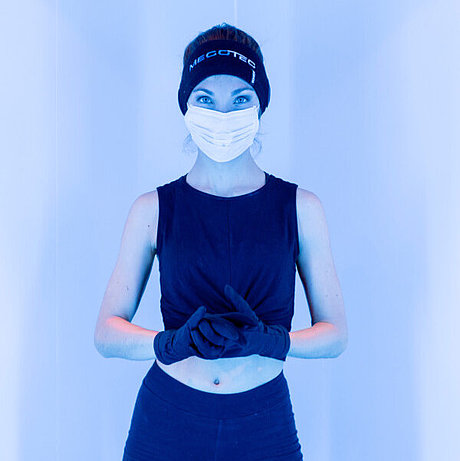Cryotherapy

Cold therapy: Process & Mode of application
Cryotherapy (Greek kryo=cold) or cryogenic therapy originates from physical medicine. Various physical complaints can be alleviated by the effect of cold. In addition to local application, which is limited to certain areas of the body at a time, there is also whole body cryotherapy (WBC) in a cold chamber.
How does cold therapy work?
Cold therapy is a branch of thermotherapy that makes use of an organism's reactions to large differences between its own body temperature and the ambient temperature. When the surface temperature of the skin is lowered quickly, the mediators that cause inflammation become inactive and thus inflammatory processes are greatly slowed down. However, cold stimuli also have a number of other benefits.
Other possible benefits of cryo treatements:
- Stimulation of blood circulation
- Reduction of fluid retention (effective for oedema)
- Alleviation of the sensation of pain
- Reduction of muscle tension
Temperatures down to -110 degrees Celsius
The temperature drop in MECOTEC chambers for cryo treatments is created by using compression technology to strongly cool down air. This principle is used both for local cold therapy devices and for cold chambers.
Multi-room cryo chambers
The MECOTEC multi and multi+ model series for the highly professional sector consists of several components. Patients first spend a short time in an antechamber of -60 °C to familiarise themselves with the cold. They then move to the main chamber for several minutes with temperatures of up to -110 degrees Celsius.
Single-chamber systems
As part of the range of options, many 1-chamber solutions are used both in the private and in the professional sector (e.g. homes, doctor's practice, fitness centre). These require a small footprint and are extremely economical to purchase and operate. In our cryo:one, cryo:one+ and cryoair flex models you can expect cryogenic temperatures up to -85 °C.
Multiple fields of application
Cryo treatment has been used primarily in the medical field as cold therapy: to combat chronic diseases such as rheumatism, arthritis, neurodermatitis or neuronal disorders, as well as to relieve pain and inflammation caused by injuries and/or tension.
The possible applications have progressed overtime and extend far beyond its medical origins. For example, the procedure can also be found in competitive sports. Athletes like to use the cold shock generated by cryo treatments after hard training sessions to recuperate, or shortly before training to improve performance. In addition, cold chambers are increasingly finding their way into the fitness and wellness sector as a form of biohacking. At the same time, cold therapy is even used for mental strengthening. The icy temperatures release adrenaline and endorphins, which often noticeably brightens the mood of many patients after a session.
Applications of cold therapy can assist in:
• Combating chronic diseases (e.g. rheumatism)
• Relieving pain and inflammation
• Rejuvenation in competitive sports and fitness
• wellness treatments
• mental upset (e.g. depression, anxeity)
How does a treatment proceed?
In order to expose the largest possible body surface to the cold, the user should enter the cryo chamber in light swimwear. To prevent frostbite, the extremities are protected by thick gloves and socks. For the face, a mouth guard and a headband are recommended. Metal objects such as piercings or jewellery and glasses must be removed before each treatment..

How often should a treatment take place?
Even a single cryo treatment can ensure that users that experience pain, for example, are free of symptoms for a few hours to several days. In order to consolidate the effect of cryotherapy, regular sessions are necessary. Athletes like to adjust the frequency of sessions to their training cycles and make use of the cryo chamber two or three times a week. High-performance athletes, on the other hand, sometimes expose themselves to cryogenic therapy every day.
Origin of cryotherapy
Cryotherapy already had its beginnings in antiquity. The pain-relieving effect of cooling individual parts of the body was documented in the Corpus Hippocraticum (6th century BC to 2nd century AD). However, it was to take until the 20th century before cold therapy was also used holistically. The first precursors were the so-called Kneipp baths of 1821, and a type of such bath still exists today in the form of the ice barrel. The nitrogen-cooled cold sauna, which is still used today, was developed 150 years later, in the late 1970s, by the Japanese rheumatologist Toshima Yamauchi. Today, modern cold chambers are electrically operated. The pioneer among electric cold chambers is the company MECOTEC.

